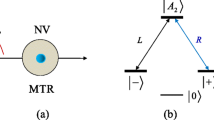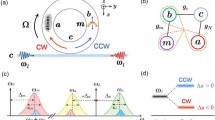Abstract
We theoretically present a scheme for enhancing the entanglement between the two mechanical resonators in a hybrid optomechanical system which is consisted of two mechanical resonators coupled via Coulomb field, two cavities and a nitrogen-vacancy (NV) center ensemble inside the left cavity. We demonstrate that the enhancement of mechanical entanglement is strongly manipulated by the Coulomb coupling strength. Our result also shows that the collective spin coupling strength plays an important role in attaining the reinforced mechanical entanglement. Moreover, the mechanical entanglement can be increased by properly selecting the optomechanical coupling strength and other system parameters. Further, it is found that the steady-state entanglement of the hybrid system can be obtained easily in a large range of parameters. Our work provides broad potential applications in the investigation of quantum information processing and the preparation of quantum devices.
Graphical abstract
Quantum entanglement, cavity optomechanics, NV center ensemble, Coulomb coupling.








Similar content being viewed by others
Data Availability Statement
This manuscript has no associated data or the data will not be deposited. [Authors comment: The manuscript has no data associated with it].
References
J.C. Boileau et al., Robust quantum communication using a polarization-entangled photon pair. Phys. Rev. Lett 93, 220501 (2004)
X. Lu et al., Chip-integrated visible–telecom entangled photon pair source for quantum communication. Nat. Phys. 15, 373–381 (2019)
R. Heilmann et al., A novel integrated quantum circuit for high-order W-state generation and its highly precise characterization. Sci. Bull. 60, 96–100 (2015)
S. Kiesewetter et al., Pulsed entanglement of two optomechanical oscillators and Furry’s hypothesis. Phys. Rev. Lett. 119, 023601 (2017)
X.S. Ma et al., Quantum teleportation over 143 kilometres using active feed-forward. Nat. 489, 269–273 (2012)
M. Riebe et al., Deterministic quantum teleportation with atoms. Nature 429, 734–737 (2004)
A.K. Ekert, Quantum cryptography and bell’s theorem (Springer, Boston, MA, 1992)
A. Einstein, B. Podolsky, N. Rosen, Can quantum-mechanical description of physical reality be considered complete? Phys. Rev. 47, 777 (1935)
H.J. Kimble, The quantum internet. Nature 453, 1023–1030 (2008)
H.M. Li et al., Measurement-induced nonclassical state from two-mode squeezed vacuum states via beam splitter and its entanglement properties. Laser Phys. Lett. 16, 105202 (2019)
H.C. Yuan et al., Quantifying micro–macro entanglement of a single-photon entangled state by virtue of Wigner function method. Modern Phys. Lett. A 30, 1550109 (2015)
Q. Liao, G. He, Maximal entanglement and switch squeezing with atom coupled to cavity field and graphene membrane. Quantum Inf. Proc. 19, 1–15 (2019)
Z.J. Ke et al., Detection and quantification of entanglement with measurement-device-independent and universal entanglement witness. Chinese Phys. B 29, 080301 (2020)
C. Joshi et al., Entanglement of distant optomechanical systems. Phys. Rev. A 85, 033805 (2012)
M. Wang et al., Macroscopic quantum entanglement in modulated optomechanics. Phys. Rev. A 94, 053807 (2016)
F.X. Sun et al., Phase control of entanglement and quantum steering in a three-mode optomechanical system. New J. Phys. 19, 123039 (2017)
A. Sohail et al., Enhancement of mechanical entanglement in hybrid optomechanical system. Quantum Inf. Proc. 19, 1–18 (2020)
X. Xiao et al., Tunable optical second-order sideband effects in a parity-time symmetric optomechanical system. Sci. China Phys. Mech. Astron. 63, 1–8 (2020)
P. Meystre, A short walk through quantum optomechanics. Ann. Der Physik. 525, 215–233 (2013)
R. Ghobadi, A.R. Bahrampour, C. Simon, Quantum optomechanics in the bistable regime. Phys. Rev. A 84, 033846 (2011)
M. Bhattacharya, P. Meystre, Trapping and cooling a mirror to its quantum mechanical ground state. Phys. Rev. Lett. 99, 073601 (2007)
Z. Yin, T. Li, M. Feng, Three-dimensional cooling and detection of a nanosphere with a single cavity. Phys. Rev. A 83, 013816 (2011)
Z. Xu, T. Li, Detecting Casimir torque with an optically levitated nanorod. Phys. Rev. A 96, 033843 (2017)
Q.H. Liao et al., Transparency and tunable slow-fast light in a hybrid cavity optomechanical system. Opt. Express 28, 5288–5305 (2020)
S. Weis et al., Optomechanically induced transparency. Science 330, 1520–1523 (2010)
I. Wilson-Rae et al., Theory of ground state cooling of a mechanical oscillator using dynamical backaction. Phys. Rev. Lett. 99, 093901 (2007)
W. Zeng et al., Ground-state cooling of a mechanical oscillator in a hybrid optomechanical system including an atomic ensemble. Sci. Rep. 7, 1–10 (2017)
A. Pontin et al., Dynamical two-mode squeezing of thermal fluctuations in a cavity optomechanical system. Phys. Rev. Lett. 116, 103601 (2016)
K. Børkje et al., Observability of radiation-pressure shot noise in optomechanical systems. Phys. Rev. A 82, 013818 (2010)
T. Bagci et al., Optical detection of radio waves through a nanomechanical transducer. Nature 507, 81–85 (2014)
S. Forstner et al., Ultrasensitive optomechanical magnetometry. Adv. Mater. 26, 6348–6353 (2014)
S. Huang, G.S. Agarwal, Robust force sensing for a free particle in a dissipative optomechanical system with a parametric amplifier. Phys. Rev. A 95, 023844 (2017)
R.W. Andrews et al., Bidirectional and efficient conversion between microwave and optical light. Nature Phys. 10, 321–326 (2014)
A. Bassi et al., Models of wave-function collapse, underlying theories, and experimental tests. Rev. Modern Phys. 85, 471 (2013)
D. Vitali et al., Optomechanical entanglement between a movable mirror and a cavity field. Phys. Rev. Lett. 98, 030405 (2007)
M.J. Hartmann, M.B. Plenio, Steady state entanglement in the mechanical vibrations of two dielectric membranes. Phys. Rev. Lett. 101, 200503 (2008)
Y.D. Wang, A.A. Clerk, Reservoir-engineered entanglement in optomechanical systems. Phys. Rev. Lett. 110, 253601 (2013)
G. De Chiara, M. Paternostro, G.M. Palma, Entanglement detection in hybrid optomechanical systems. Phys. Rev. A 83, 052324 (2011)
B. Rogers et al., Entanglement control in hybrid optomechanical systems. Phys. Rev. A 86, 042323 (2012)
H. Levine et al., High-fidelity control and entanglement of Rydberg-atom qubits. Phys. Rev. Lett. 121, 123603 (2018)
K. Stannigel et al., Optomechanical transducers for long-distance quantum communication. Phys. Rev. Lett. 105, 220501 (2010)
T.D. Ladd et al., Quantum computers. Nature 464, 45–53 (2010)
F. Dolde et al., Room-temperature entanglement between single defect spins in diamond. Nature Phys. 9, 139–143 (2013)
M.W. Doherty et al., The nitrogen-vacancy colour centre in diamond. Phys. Rep. 528, 1–45 (2013)
R. Schirhagl et al., Nitrogen-vacancy centers in diamond: nanoscale sensors for physics and biology. Annu. Rev. Phys. Chem. 65, 83–105 (2014)
V.M. Acosta et al., Diamonds with a high density of nitrogen-vacancy centers for magnetometry applications. Phys. Rev. B 80, 115202 (2009)
L. Thiel et al., Probing magnetism in 2D materials at the nanoscale with single-spin microscopy. Science 364, 973–976 (2019)
G. Balasubramanian et al., Nanoscale imaging magnetometry with diamond spins under ambient conditions. Nature 455, 648–651 (2008)
J.R. Maze et al., Nanoscale magnetic sensing with an individual electronic spin in diamond. Nature 455, 644–647 (2008)
G. Balasubramanian et al., Ultralong spin coherence time in isotopically engineered diamond. Nature Mat. 8, 383–387 (2009)
I. Aharonovich et al., Two-level ultrabright single photon emission from diamond nanocrystals. Nano Lett. 9, 3191–3195 (2009)
E. Togan et al., Quantum entanglement between an optical photon and a solid-state spin qubit. Nature 466, 730–734 (2010)
W.J. Su, Z.B. Yang, Z.R. Zhong, Arbitrary control of entanglement between two nitrogen-vacancy-center ensembles coupling to a superconducting-circuit qubit. Phys. Rev. A 97, 012329 (2018)
D. Marcos et al., Coupling nitrogen-vacancy centers in diamond to superconducting flux qubits. Phys. Rev. Lett. 105, 210501 (2010)
T. Hümmer et al., Nonequilibrium phases in hybrid arrays with flux qubits and nitrogen-vacancy centers. Phys. Rev. A 85, 052320 (2012)
L.J. Zou et al., Implementation of the Dicke lattice model in hybrid quantum system arrays. Phys. Rev. Lett. 113, 023603 (2014)
T. Liu et al., One-step implementation of a hybrid Fredkin gate with quantum memories and single superconducting qubit in circuit QED and its applications. Opt. Express 26, 4498–4511 (2018)
S. Ma et al., Two-mode squeezed states of two separated nitrogen-vacancy-center ensembles coupled via dissipative photons of superconducting resonators. Phys. Rev. A 99, 012325 (2019)
Y. Kubo et al., Hybrid quantum circuit with a superconducting qubit coupled to a spin ensemble. Phys. Rev. Lett. 107, 220501 (2011)
S. Saito et al., Towards realizing a quantum memory for a superconducting qubit: Storage and retrieval of quantum states. Phys. Rev. Lett. 111, 107008 (2013)
B. Li et al., Quantum microwave-optical interface with nitrogen-vacancy centers in diamond. Phys. Rev. A 96, 032342 (2017)
Z. Chen et al., Dissipative quantum phase transition in a biased Tavis-Cummings model. Chinese Phys. B 29, 044201 (2020)
T. Liu et al., One-step implementation of a coherent conversion between microwave and optical cavities via an ensemble of nitrogen-vacancy centers. Phys. Rev. A 103, 023706 (2021)
U. Löw et al., Study of an Ising model with competing long-and short-range interactions. Phys. Rev. Lett. 72, 1918 (1994)
R.X. Chen, L.T. Shen, S.B. Zheng, Dissipation-induced optomechanical entanglement with the assistance of Coulomb interaction. Phys. Rev. A 91, 022326 (2015)
J. Xu, T. Liu, Transfer of arbitrary quantum states between separated superconducting cavities via an ensemble of nitrogen-vacancy centers. Results Phys. 44, 106157 (2023)
M.J.A. Schütz, Universal quantum transducers based on surface acoustic waves. Quantum Dots Quantum Inform. Proc. Controll. Exploit. Quantum Dot Environ. p. 143-196 (2017)
T. Holstein, H. Primakoff, Field dependence of the intrinsic domain magnetization of a ferromagnet. Phys. Rev. 58, 1098 (1940)
V. Giovannetti, D. Vitali, Phase-noise measurement in a cavity with a movable mirror undergoing quantum Brownian motion. Phys. Rev. A 63, 023812 (2001)
A. Jackson, J. Mavoori, E.E. Fetz, Long-term motor cortex plasticity induced by an electronic neural implant. Nature 444, 56–60 (2006)
X.Y. Lü et al., Steady-state mechanical squeezing in an optomechanical system via Duffing nonlinearity. Phys. Rev. A 91, 013834 (2015)
T.A. Palomaki et al., Entangling mechanical motion with microwave fields. Science 342, 710–713 (2013)
W. Xiong et al., Strong long-range spin-spin coupling via a Kerr magnon interface. Phys. Rev. B 105, 245310 (2022)
Acknowledgements
This project was supported by the National Natural Science Foundation of China (Grant No. 62061028), the Opening Project of Shanghai Key Laboratory of Special Artificial Microstructure Materials and Technology (Grant No. ammt2021A-4), the Foundation for Distinguished Young Scientists of Jiangxi Province (Grant No. 20162BCB23009), the Open Research Fund Program of the State Key Laboratory of Low-Dimensional Quantum Physics (Grant No. KF202010), the Interdisciplinary Innovation Fund of Nanchang University (Grant No. 9166-27060003-YB12), and the Open Research Fund Program of Key Laboratory of Opto-Electronic Information Acquisition and Manipulation of Ministry of Education (Grant No. OEIAM202004).
Author information
Authors and Affiliations
Contributions
QL: Supervision, Conceptualization, Methodology, Writing—Reviewing and Editing. RL: Writing—Original draft preparation, Data curation. QZ: Visualization, Investigation. ZZ: Validation.
Corresponding authors
Ethics declarations
Conflict of interest
The authors certify that they have no competing financial interests or personal relationship.
Consent for publication
If accepted, the article will not be published elsewhere in the same form, in any language, without the written consent of the publisher.
Rights and permissions
Springer Nature or its licensor (e.g. a society or other partner) holds exclusive rights to this article under a publishing agreement with the author(s) or other rightsholder(s); author self-archiving of the accepted manuscript version of this article is solely governed by the terms of such publishing agreement and applicable law.
About this article
Cite this article
Liu, R., Liao, Q., Zhao, Q. et al. Enhanced entanglement in the hybrid optomechanical system assisted by the nitrogen-vacancy center ensemble in diamond. Eur. Phys. J. D 77, 84 (2023). https://doi.org/10.1140/epjd/s10053-023-00654-0
Received:
Accepted:
Published:
DOI: https://doi.org/10.1140/epjd/s10053-023-00654-0




